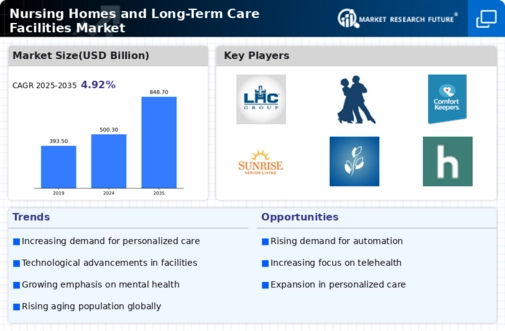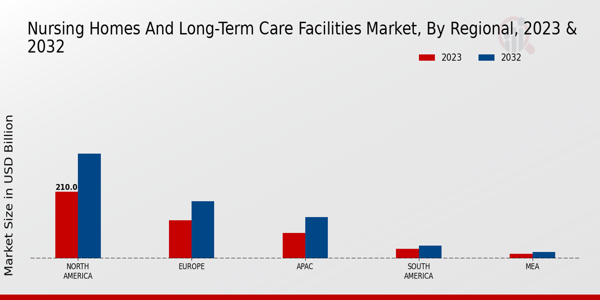Aging Population
The Global Nursing Homes and Long-Term Care Facilities Market Industry is experiencing a notable surge due to the increasing aging population. By 2024, the global population aged 65 and older is projected to reach approximately 1.5 billion, significantly impacting the demand for long-term care services. This demographic shift necessitates a robust infrastructure to support elderly care, leading to a projected market value of 500.3 USD Billion in 2024. As the elderly population continues to grow, the industry must adapt to meet their unique healthcare needs, thereby driving market expansion.
Rising Chronic Diseases
The prevalence of chronic diseases among the elderly is a critical driver for the Global Nursing Homes and Long-Term Care Facilities Market Industry. Conditions such as diabetes, heart disease, and dementia require ongoing management and specialized care, which nursing homes are equipped to provide. As of 2024, it is estimated that over 80 percent of older adults have at least one chronic condition, further emphasizing the necessity for long-term care facilities. This trend is likely to contribute to the market's growth, with projections indicating a value of 848.7 USD Billion by 2035.
Market Growth Projections
The Global Nursing Homes and Long-Term Care Facilities Market Industry is poised for substantial growth, with projections indicating a market value of 500.3 USD Billion in 2024 and an anticipated increase to 848.7 USD Billion by 2035. This growth trajectory reflects a compound annual growth rate of 4.92% from 2025 to 2035, driven by various factors such as an aging population, rising chronic diseases, and technological advancements. The market's expansion is indicative of the increasing demand for long-term care services, necessitating ongoing investment and innovation within the industry.
Technological Advancements
Technological innovations are reshaping the Global Nursing Homes and Long-Term Care Facilities Market Industry, enhancing the quality of care provided to residents. The integration of telehealth services, electronic health records, and assistive technologies facilitates better monitoring and management of patients' health. These advancements not only improve operational efficiency but also elevate the standard of care, making facilities more appealing to potential residents. As the industry evolves, the adoption of technology is expected to play a pivotal role in driving market growth, contributing to a compound annual growth rate of 4.92% from 2025 to 2035.
Government Initiatives and Funding
Government initiatives aimed at improving healthcare access and quality are significantly influencing the Global Nursing Homes and Long-Term Care Facilities Market Industry. Various countries are implementing policies that increase funding for long-term care services, thereby enhancing the infrastructure and resources available to nursing homes. For instance, increased budget allocations for elder care programs can lead to improved facilities and services, attracting more residents. This supportive environment is likely to bolster market growth, as governments recognize the importance of addressing the needs of an aging population.
Increased Awareness of Long-Term Care Options
There is a growing awareness among families regarding the importance of long-term care options, which is driving the Global Nursing Homes and Long-Term Care Facilities Market Industry. As more families seek suitable care solutions for their elderly relatives, the demand for nursing homes and long-term care facilities is expected to rise. Educational campaigns and resources are helping families understand the benefits of professional care, leading to informed decisions. This heightened awareness is likely to contribute to the market's expansion, as families prioritize quality care for their loved ones.















